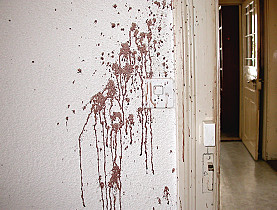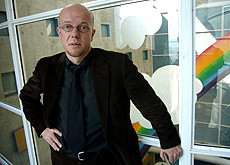When bloodstains say more than DNA

Enthusiasm is catching among European police for a crime-detection technique developed in North America.
Among them were around 140 sleuths who gathered in Zurich at the beginning of July for a European conference on “bloodstain pattern analysis”.
“DNA analysis, which has certainly led to enormous progress in criminal science, is overestimated,” public prosecutor Ulrich Weber, head of the Zurich prosecutor’s office in charge of violent crimes, told the conference.
“It does not, for example, tell us much about the unfolding of events.”
Analysis of bloodstain patterns at crime scenes can say much more about the sequence of events of a crime than just DNA. The techniques for making use of these stains are still fairly unknown in Europe, but that is changing.
To catch up with their North American counterparts, European police have created a branch of the International Association of Bloodstain Pattern Analysts (IABPA), which counts 800 members in the world and organises its own annual conferences.
Andreas Schweizer, investigating officer at the biological section of the scientific service of Zurich police, referred to a case from earlier this year.
“The police found a man stabbed to death in his bed. The knife was beside him. Analysis of blood traces, the form and position of the injuries revealed that the man had committed suicide and the involvement of another person was excluded.”
Blood bath
In another case without a body, the identity of a murderer could have been mistaken. “The chemiluminescent [chemical reaction between heat and light] product Liminol found that there had been blood in the bath, although nothing was visible to the naked eye,” Weder said.
Why is the method only today gaining support? According to Andre Hendrix, the Dutch investigating officer who organised the first European conference, “we just forgot about it”.
“Luminol, which shows up evidence of stains that have been removed, existed at the start of the 20th century but it has not been developed for decades,” Hendrix said.
“It is true that chemical products that were being used were destroying DNA. Now we have products that are less aggressive for other kinds of traces. Scientific research has given impetus to the field.”
Bomb explosions
At the Zurich conference, the participants heard from, among others, an expert from the Swiss-Italian police speaking on methods used after bomb explosions.
The latest developments in chemical matter and ballistics analysis of bloodstains were also presented.
“Today we are capable of determining the angle of blood spilt on a hard surface,” said Canada’s Brian Allen, who led a workshop presenting a “painting” of splattered blood.
Participants learned from the example and Allen’s experience to interpret how the drops fell on the surface.
“Switzerland is still a little under-resourced in this field. But it is very useful to be able to practise this,” said Priscille Merciani of the Bern cantonal police.
swissinfo, Ariane Gigon in Zurich
Basic criminal police training in Europe does not yet include bloodstain analysis. Investigating officers who want to specialise must follow courses organised regularly in Europe.
The heads of the Zurich police scientific service say five Swiss officers have had the basic training, three in Zurich and two in Ticino.
Just one Swiss investigating officer has been fully trained in the field. But interest is strong and numbers are expected to multiply in the coming years.
Luminol is a chemical product that produces a chemical luminosity, with a characteristic blue sheen when oxidized. It is made of white to light yellow solid crystalline that dissolves in water and most organic polar solvents.
Luminol is used in criminology to detect faint traces of blood left at crime scenes. It is also used by biologists for observing leather, iron and cyanide.

In compliance with the JTI standards
More: SWI swissinfo.ch certified by the Journalism Trust Initiative



You can find an overview of ongoing debates with our journalists here. Please join us!
If you want to start a conversation about a topic raised in this article or want to report factual errors, email us at english@swissinfo.ch.